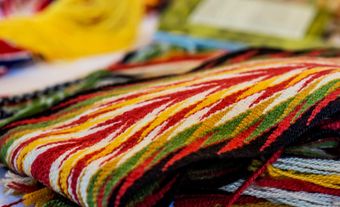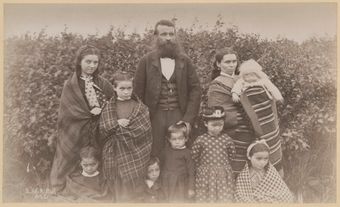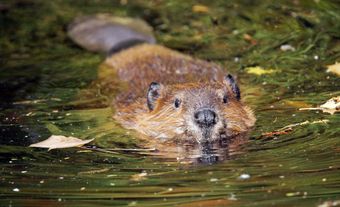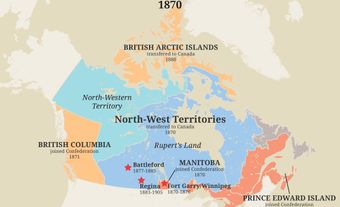Marie-Anne Lagimodière (née Gaboury), settler (born 2 August 1780 in Maskinongé, QC; died 14 December 1875 in St. Boniface, MB). Marie-Anne Lagimodière accompanied her fur-trader husband, Jean-Baptiste Lagimodière, to what is now Western Canada. She was one of the first women of European descent in the area and they became some of the first settlers in Red River. Marie-Anne Lagimodière was grandmother of Louis Riel, the Métis leader of the Red River Resistance.

Early Life and Marriage
Marie-Anne Lagimodière was born in Maskinongé, a village some 45 km southwest of Trois-Rivières in modern-day Quebec. Marie-Anne’s parents, Charles Gaboury and Marie-Anne Tessier were tenant farmers (see Seigneurial System). Both sides of her family were descended from French Canadians. When her father died in 1792, the family moved to a smaller farm. Around age 12, Lagimodière became an assistant housekeeper for the parish priest.
She met Jean-Baptiste Lagimodière (sometimes spelled Lagimonière, Lajimodière, or Lagemodière), a fur-trader who had recently returned from the west, in 1805. The couple married in April 1806. Lagimodière signed her name on their marriage contract, an indication that she had basic literacy skills at the least.
Jean-Baptiste had intended to settle in Maskinongé, but soon decided that he wanted to rejoin the lucrative fur trade in the West. Lagimodière was unsuccessful in convincing her husband to stay, so she decided to join him. Had she stayed behind, she would have only seen her husband for a couple of months every few years. This decision made her one of the first women of European descent to travel into what is now Western Canada (see History of Settlement in the Canadian Prairies).
Journey to the Northwest
In Spring 1806, the couple embarked on their 2,200 km journey to Pembina, a trading post along the Red River about 100 km south of Winnipeg (now in North Dakota). From Montreal, they departed in a canot de maître, a 12 m long canoe that could carry up to 12 people. On the journey, Lagimodière would have helped set up camp, cook and do mending.
At a rendezvous point in Fort William, they stocked up on supplies. For the remaining 1,100 km of their trip, they travelled in a smaller canot du nord. Their journey included numerous portages, and they arrived in Pembina in August 1806.
Life on the Plains
By the time they arrived, Marie-Anne Lagimodière was expecting their first child. In Pembina, she learned that Jean-Baptiste had been married to a Cree woman, with whom he had three daughters. Intermarriage between voyageurs and Indigenous women, mariage à la façon du pays as it was known (“marriage according to the custom of the country”), was an important part of the fur trade. After Lagimodière’s arrival in Pembina, this Cree family disappears from record.
In the fall of 1806, the couple joined a buffalo hunt but returned to Pembina for the birth of their first child on 6 January 1807. Their daughter, Reine, is believed to be the first White child born in Western Canada. The Indigenous women taught Lagimodière to use a cradle board, a baby carrier that allowed her to continue working.
In 1807, the family travelled 1,350 km with three other “freemen” (or, coureurs des bois) and their Cree wives to the area near Fort Edmonton. They lived on the open plains for months at a time. In the summers, Lagimodière accompanied her husband on buffalo hunts. In the winters, she would stay at Fort Edmonton with their children while Jean-Baptiste went trapping.

Red River Settlement
Marie-Anne Lagimodière wished for a more permanent lifestyle for their family and in 1811, news of a settlement along the Red River prompted them to return to the area. Thomas Douglas, Lord Selkirk, was establishing the Red River Colony for displaced Scottish highlanders. The Lagimodières, alongside Indigenous and Métis families, began to settle in the area before the establishment of this colony.
After Selkirk’s settlers arrived, tensions built between trading companies (the Hudson’s Bay Company and North West Company), settlers, Indigenous groups, and Métis (see also Pemmican Proclamation). In October 1815, Jean-Baptiste was dispatched to deliver a message to Lord Selkirk in Montreal about threats to the colony. While he was gone, Lagimodière and their children stayed at Fort Douglas in Selkirk’s settlement.
In June 1816, tensions culminated in the Battle of Seven Oaks when a group of Métis faced off against Hudson’s Bay Company men.Concerned for her family’s safety at Fort Douglas, Lagimodière sought refuge with Peguis, a Saulteaux chief.
Lord Selkirk arrived in Red River in June 1817 to rebuild his colony and, as a reward for his service, granted Jean-Baptiste land on the east bank of the Red River. Here, they built a frame house and continued to expand their family. This area would become St. Boniface, a French community.
In 1818, the first Catholic missionaries arrived in Red River and baptized over 100 children (see Missions and Missionaries). As the only baptized woman in the area, Lagimodière was godmother to all of them. Lagimodière’s last child was born in 1825; she had as many as 10 children, eight of whom survived. By 1832, the Lagimodière family farm was over 11 hectares.
Later Life
Despite crop losses and floods, Marie-Anne Lagimodière and her family remained in Red River and their farm prospered. After Jean-Baptiste’s death in 1855, Lagimodière lived with her son Benjamin. All of the couple’s eight children survived into adulthood. Among their 64 grandchildren were Louis Riel, Métis leader of the Red River Resistance, and Sara Riel, the first Métis Grey Nun.
Lagimodière died on 14 December 1875 at age 95 in St. Boniface.
Significance and Legacy
Marie-Anne and Jean-Baptiste Lagimodière have been recognized for their role in the history of Manitoba. Lagimodière-Gaboury Park in St. Boniface and Lagimodière Boulevard and École Marie-Anne Gaboury in Winnipeg have been named in their honour. The Cereal Research Centre in Winnipeg named a variety of oats AC Marie after Lagimodière (see Cereal Crops).
As the first woman of European descent to permanently settle in what is now Western Canada, Lagimodière has been referred to as the “White Mother of the West.” In 1982, she was designated a Person of National Historic Significance.

 Share on Facebook
Share on Facebook Share on X
Share on X Share by Email
Share by Email Share on Google Classroom
Share on Google Classroom










